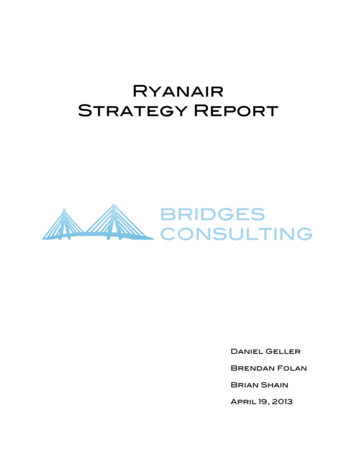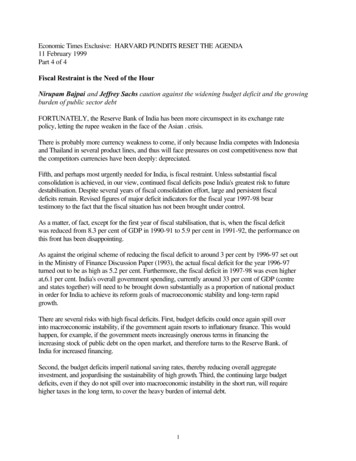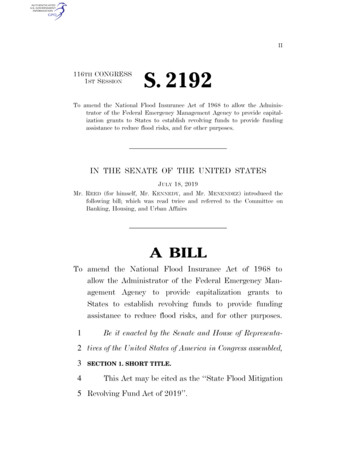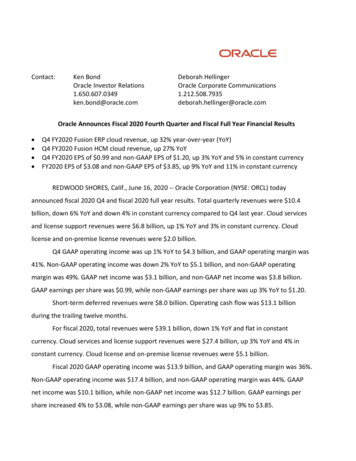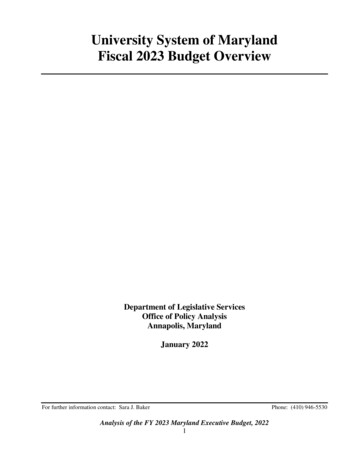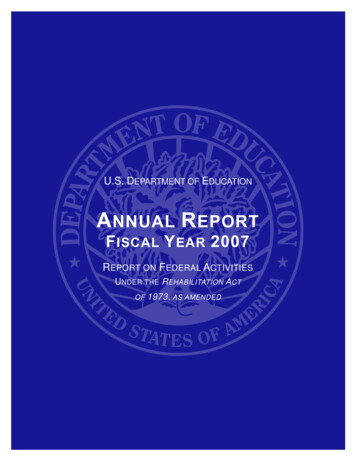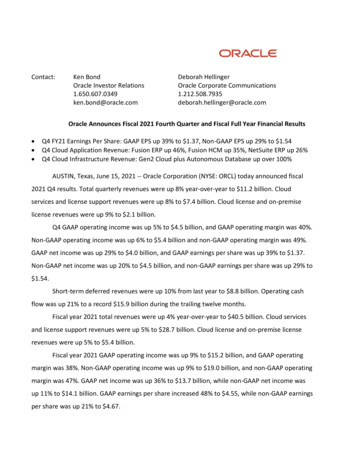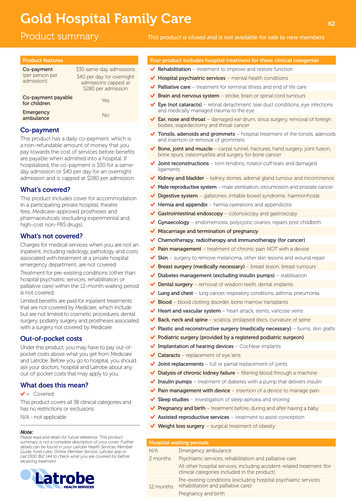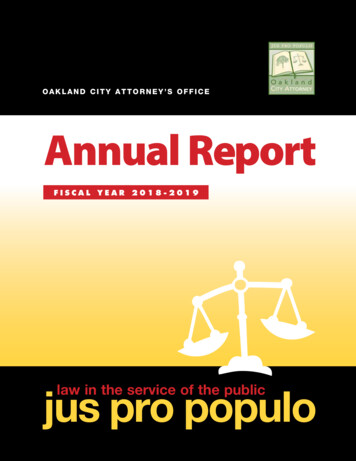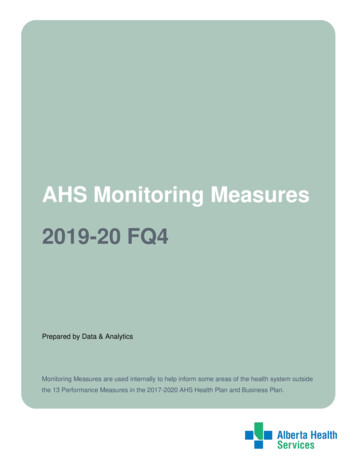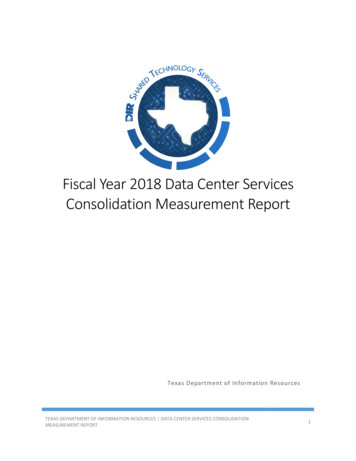
Transcription
Fiscal Year 2018 Data Center ServicesConsolidation Measurement ReportTexas Department of Information ResourcesTEXAS DEPARTMENT OF INFORMATION RESOURCES DATA CENTER SERVICES CONSOLIDATIONMEASUREMENT REPORT1
Table of ContentsExecutive Summary. 3Data Center Services Program Background . 3Consolidation Measurement Report . 4Baseline Assessment of Financial Performance. 5Program Performance. 5Fiscal Year 2018 Unit Rate Analysis . 7Transition and Transformation . 9DCS Infrastructure Consolidation Progress. 10Consolidation Status . 10DCS Program Progress . 10Conclusion . 12Appendix A – Unit Rate Analysis Methodology . 13Methodology. 13Base Rates . 14Inclusion/Exclusion of Resource Units . 14Appendix B – Detailed Unit Rate Analysis. 16Mainframe . 16Print-Mail . 16Server Services . 16Server Storage and Tape Services . 16MSI Charges . 17Appendix C – DCS Customer Analysis . 18Voluntary Customers4 . 36Appendix D – Definition of Terms . 38Acknowledgements. 40TEXAS DEPARTMENT OF INFORMATION RESOURCES DATA CENTER SERVICES CONSOLIDATIONMEASUREMENT REPORT2
Executive SummaryData Center Services Program BackgroundAs the state’s Information Technology (IT) agency, the Texas Department of Information Resources (DIR)provides customers with IT products and services as well as policy, planning, and guidance that helpshape consistent and effective use of technology across Texas. In 2005, the 79th Legislature passedHouse Bill 1516, directing DIR to consolidate agencies’ IT infrastructure to reduce statewide costs for ITservices, modernize aging state infrastructure, and increase overall security and disaster recoverycapability. The goal of the legislation was to reduce taxpayer costs by consolidating and standardizing ITinfrastructure, products, and services across agencies with large IT investments. Additionally, the Statesought to reduce disaster recovery risks, security risks, and critical state data and system assets backuprisks, as well as to stay current with IT best practices.In 2006, 29 state agencies were selected to participate in the data center consolidation. DIR released arequest for offer to outsource the management of these agencies’ IT infrastructure, while consolidatingfrom more than 31 disparate, legacy data centers into two highly secure, redundant data centers inAustin and San Angelo. With designated agency participation, DIR entered a seven-year contract in 2007to operate the Data Center Services (DCS) Program. In 2010, DIR re-procured and re-structured DCS intoa service integration model with multiple Service Component Providers (SCP) and a Multi-SourcingServices Integrator (MSI) that positioned the state to achieve more flexibility, accountability, andfunctionality.DIR continues to provide customers additional services through expanded DCS offerings. In 2017, DIRexecuted two optional Managed Application Services (MAS) contracts, one for application developmentand maintenance and a second for application services-rate card. These contracts allow customers toreinvest infrastructure consolidation savings to continue modernizing legacy applications. In 2018, DIRexecuted a Managed Security Services (MSS) contract to provide customers with access to securitymonitoring and device management, incident response, and risk and compliance services.The DCS Program is open to all Texas state agencies, institutions of higher education, and localgovernmental entities. DCS services include mainframe, server, bulk print/mail, disaster recovery,backup, monitoring, security, storage, production control, data center network, architecture design,capacity management, operating system support, database support, middleware support, hardwarerefresh, software currency and facilities. The program currently invoices 74 state entities including 24designated state agencies with fully managed mainframe, server, and bulk print-mail services, meaningthat DIR, through its SCP vendors, provide the hardware, software, tools, and technical staff to fullysupport IT infrastructure. This report excludes voluntary customers that contract with DIR but are notcurrently being invoiced.As Texas experiences rapid population and economic growth, state governmental entities must delivermore constituent services with greater efficiency. As a result, the state is progressively investing in IT toaccomplish many goals. These goals include improving business operations support, pursuing costefficiencies, providing secure and innovative ways for Texans to interact with the State, enhancing thedigital experience of government services, and supporting open data initiatives to improveTEXAS DEPARTMENT OF INFORMATION RESOURCES DATA CENTER SERVICES CONSOLIDATIONMEASUREMENT REPORT3
transparency. As governments are challenged to do more with less, the ability to outsource andoptimize infrastructure and IT services becomes increasingly necessary to achieve economies of scale.The DCS Program provides a strong foundation for an ever-growing and enhanced set of IT services byenabling government entities to meet these demands.Consolidation Measurement ReportIn 2013, the 83rd Legislature amended Texas Government Code, Section 2054.062 1 to require DIR tomeasure and report on the financial performance and progress of the data center consolidation effort.DIR is tasked with: Developing a method of measuring costs for the DCS consolidation initiative. Developing an agreed upon method for collecting and validating data to determine a baselineassessment of costs. Evaluating costs and cost savings for consolidation based on the methodology. Coordinating assessment with DIR’s internal auditor for guidance. Developing a method of measuring progress for DCS consolidation initiative. Evaluating progress for consolidation initiative. Reporting annually to primary stakeholders. Posting consolidation reports on the DIR website.In 2014, DIR contracted with a third-party to develop the cost measurement methodology and workedcollaboratively with DCS customer representatives to review and refine the proposed methodology. Theinitial DCS Consolidation Report was published on February 27, 2015. The initial report methodology, asagreed upon by DCS customers, is used in this report and provides multiple views of the DCS programfinancial performance for Fiscal Year (FY) 2018.This consolidation measurement report provides analysis and insight into the following DCS programelements:1. Baseline Assessment of Financial Performance A comparison of appropriated DCS spending versus actual customer spending. Total customer spending by service category.2. FY 2018 Unit Rate Impact Analysis Rate analysis based on volume fluctuations and total extended charges.3. Transition and Transformation Investments. A financial summary of one-time investments required to transition services andtransform and consolidate the legacy IT environment.4. DCS Infrastructure Consolidation Progress Current status of infrastructure consolidation initiatives. Description of DCS program accomplishments.The full reference of the Texas Government Code can be located via the link Texas Government Code Chapter 2054.062 54.htm1TEXAS DEPARTMENT OF INFORMATION RESOURCES DATA CENTER SERVICES CONSOLIDATIONMEASUREMENT REPORT4
Baseline Assessment of Financial PerformanceProgram PerformanceThe DCS program is highly complex and has experienced dynamic growth, services changes andexpansion, and strategic investments supporting the ongoing consolidation effort. The following sectionprovides insight into program costs in FY 2018.The FY 2018 appropriations to actual expenditures comparison reflect that the 32 agencies (24designated and eight voluntary), and Texas.gov infrastructure, underspent the original DCS appropriatedamounts by 1.6 million (shown in the Table 1 below):Table 1. FY 2018 Appropriations for DCS Agencies Versus Actual SpendingOriginal DCSAppropriation*FY 2018 245,204,915Actual - DCSInfrastructureServices 237,839,884Actual –ManagedApplicationServices 1,062,885Variance 6,302,146*Note: Appropriated amounts reflect the original DCS Services Capital Budget appropriations, plus Texas.gov infrastructure, anddo not include subsequent transfers.FY 2018 DCS appropriations were approximately 243.3 million, while actual expenditures totaledapproximately 238.0 million. DCS appropriation transfers are not captured in this analysis. Individualappropriated DCS customer analyses are presented in Appendix C. The following services comprised themajority of DCS customer spending for FY 2018: Mainframe Services: compute processing and storage services for applications hosted onmainframes.Print-Mail Services: bulk printing and mailing services, courier services, paper, and envelopes.Server Services: consolidated private cloud and non-consolidated virtual and physical computeprocessing for DCS customer applications.Server Storage and Tape Services: data storage and backup services for the consolidated andnon-consolidated servers.Managed Application Services: application maintenance, application development, and hourlyrate card) services.Managed Security Services: security monitoring and device management, incident response,and risk and compliance services.Server Hardware and Software: Hardware Service Charge for dedicated and shared servercompute processing, Software Service Charge for specific third-party software categoriesprocured for DCS customers, and rate card hours for SCP-supplied project personnel resourcesprovided on an hourly basis.TEXAS DEPARTMENT OF INFORMATION RESOURCES DATA CENTER SERVICES CONSOLIDATIONMEASUREMENT REPORT5
Transition and Transformation Milestones: transition services associated with moving from oneoutsourced environment to another outsourced environment, including knowledge transfer,process documentation, and wall-to-wall inventory. Transformation services related toupgrading and consolidating the IT-operating environment.Cross-functional, Project and Facilities: SCP cross-functional, project management, and DataCenter Facility costs.MSI Services: SCP integration and management services such as portal, service desk andapplication portfolio and hosting, service level and capacity monitoring, financial managementand chargeback, major incident management, and outreach and growth.Other Services: includes public cloud support charges, for which a discrete billing category wasnot yet developed and co-location services.Table 2 below shows the actual FY 2018 expenditures per service.Table. 2 Enterprise Billing CategoriesService CategoriesFY 2018 Actual SpendingMainframe Services 30,136,991Print-Mail Services 15,123,366Server Services 44,041,249Server Storage and Tape Services 24,762,033Managed Application Services 1,062,885Server Hardware and Software 58,920,408Transition and Transformation Services 13,936,602Public Cloud 2,916,283Cross-functional, Project and Facilities 21,861,939MSI Services 18,734,729Other 7,406,284TOTAL: 238,902,769FY18 INITIAL APPROPRIATION*: 245,204,915VARIANCE: 6,302,146*Note: Appropriated amounts reflect the original DCS Services Capital Budget appropriations, plus Tx.govInfrastructure, and do not include subsequent transfers.In addition to the 24 agencies that are required to participate in the data center as part of the state’sconsolidation initiative, all Texas state agencies, colleges, and universities can voluntarily use DCSservices. In 2013, the 83rd Legislature passed Senate Bill 866 which authorized DIR to offer data centerservices to local government entities. These services include managed Infrastructure as a Service (IaaS)which entails mainframe, private cloud and public cloud servers, bulk print and mail, disaster recovery,backup, monitoring, security, storage, production control, data center network, architecture design,capacity management, operating system support, database support, middleware support, hardwareTEXAS DEPARTMENT OF INFORMATION RESOURCES DATA CENTER SERVICES CONSOLIDATIONMEASUREMENT REPORT6
refresh, software currency, Microsoft O365, imagery and facilities, as well as Managed Application andSecurity Services.Table 3 reflects DCS spending for 42 voluntary agencies and two local government agenciesparticipating in the DCS program.Table 3. FY 2018 Actual Spending for DCS Voluntary CustomersTypeVoluntary Agencies (with no DCS BudgetAppropriation)Self-Directed and Semi-Independent AgenciesHigher Education: Colleges and UniversitiesLocal Government EntitiesTOTAL:Number9Amount 1,900,189542442 65,041 27,546 305,585 2,298,361Fiscal Year 2018 Unit Rate AnalysisThe pricing methodology DIR structured with the SCPs is a consumption-based, variable-price modelthat is common in the marketplace for outsourced services. The structure provides the state with theflexibility to pay for services consumed, with no fixed price minimum – converting a traditionally capitalintensive infrastructure to a variable-based operating expense.One of the benefits of a consumption-based pricing model is the economy of scale related to increasedconsumption that results in decreasing unit rates. In FY 2018, the Mainframe and Bulk Print- Mail servicemodel remained structured using a fixed fee, or base charge, for fixed volumes of service, called theresource baseline, with fee variations charged for volumes above or below the resource baselinethreshold. The base charge includes both fixed and variable charges required to support the resourcebaseline volume, while the variable charges reflect only the marginal cost to provide or reduce anincremental unit of service. Because of the marginal unit cost being lower than the imputed base rate,additional volumes of service create a lower overall unit rate for that service category, called AdditionalResource Charges (ARC). In reverse, a reduction in consumption creates a higher overall unit rate as thefixed cost is spread across a lower volume base, called Reduced Resource Credits (RRC).In FY 2018, with the conversion to Hybrid Cloud Services (HCS), server and server storage resource unitswere largely converted to a tiered-pricing structure in response to customer requests for fewer monthto-month rate fluctuations over the ARC/RRC model. Each of the ten tiers includes a fixed price rangefor a defined volume range.For this analysis, the Tier 6 pricing range was used to compare with actual expenditures to determinesavings. As the state anticipates increased consumption of DCS services year-over-year, a consumptionbased pricing model should be advantageous to the participating customers.TEXAS DEPARTMENT OF INFORMATION RESOURCES DATA CENTER SERVICES CONSOLIDATIONMEASUREMENT REPORT7
Table 4 below shows the variance between consumption at the 2018 base rates and the actual-invoicedconsumption. The contracted base cost represents the forecasted amount that the program andcustomers are contractually obligated to pay for base volumes and is the baseline for measuring costsavings. See Appendix A for a complete description of the unit rate analysis methodology.Table 4. Summary by Resource Unit GroupContracted BaseCostRate-Based Billing Categories (Included)Actual CostVarianceMainframe Services 27,898,326 27,963,162( 64,836)Print-Mail Services10,300,68010,811,647(510,967)Server Services32,340,99733,120,605(779,608)Server Storage and Tape Services12,075,06512,049,98725,078Multi-Sourcing Integrator Services (MSI)19,145,58618,157,594987,993 101,760,654 102,102,995( 342,340)Total:The above summary demonstrates FY 2018 variability across the DCS program with an unfavorableoutcome. Analysis of each service follows: Mainframeo Overall mainframe services consumption was slightly lower and actual expenditureswere slightly higher than the forecasted amounts resulting in an unfavorablevariance. Direct Attached Storage Device (DASD), Virtual Tape Storage (VTS), andspecialty engine consumption were favorable but decreased mainframeconsumption offset those savings.Print-Mailo Print-Mail volumes resulted in an overall unfavorable variance primarily due to printconsumption trending lower than the base volumes. Additionally, courier servicesconsumption decreased.Server Serviceso Server Services volumes were generally lower than the forecast volumes causing therates to fall into the less-discounted tiers.Server Storage and Tape Serviceso Overall Server Storage and Tape consumption was slightly higher and actualexpenditures were slightly lower than the forecast resulting in a favorable variance.MSI Chargeso MSI Charges resulted in a favorable variance. As customer consumption increasesmore slowly than forecasted, corresponding MSI charges accumulate higher thananticipated savings.TEXAS DEPARTMENT OF INFORMATION RESOURCES DATA CENTER SERVICES CONSOLIDATIONMEASUREMENT REPORT8
A more detailed description of the unit rate analysis methodology is included in Appendix A. TheDetailed Unit Rate Analysis is documented in Appendix B and the individual DCS customer analyses aredocumented in Appendix C.NOTE: To facilitate a technology upgrade, the DCS program instituted a freeze on Enterprise Tapefluctuations in January 2015; the four Resource Unit Categories below remained frozen throughout FY2018 and were invoiced under the Enterprise Tape Resource Unit based on an agreed amount. Consolidated Tape StoredConsolidated Tape WrittenNon-Consolidated Tape OtherNon-Consolidated Tape StoredIn January 2015, DIR worked with the SCP to implement an Enterprise Tape/Backup freeze and costreduction, resulting in an estimated reduction of 2.52 million annually. Effective September 1, 2016,the Enterprise Tape/Backup amount was further reduced by 1.38 million annually, which eliminatedthe full 3.9 million unfavorable variance noted in the DCS pricing benchmark completed in April 2016.This reduced, fixed monthly backup charge continued through FY 2018 and is anticipated to remain inplace until the Enterprise Tape/Backup Resource Units are repriced, and volumes adjusted followingcompletion of the migration to the new backup technology.Transition and TransformationIn addition to the consumption-based charges that compensate the SCPs for day-to-day delivery of ITservices, there are also separate transition and transformation charges for certain activities andinvestments that occur during the first 48 months of the DCS Master Services Agreement.The Transition and Transformation (T&T) phase is summarized into four initiatives:1. Transition. The takeover of services from the incumbent provider with minimal impacton the performance of the operations. Includes knowledge transfer and documentation,as well as the implementation of service management tools and processes to facilitate asmooth transition when the new service providers take over the operations.2. Stabilization. Includes remediating the environment, addressing assets needingimmediate refresh, implementing a new backup and recovery solution, and completinga comprehensive inventory.3. Consolidation. The multi-year effort to complete the migration of servers (and relatedstorage and backup environments) from legacy data centers and agency business officesinto consolidated data centers.4. Optimization. Ongoing improvements to the environment that will benefit the state byreducing costs and improving services.The cost of these activities totals 89.28 million, which the state pays upon successful completion ofdefined milestones from monies collected from state agencies for DCS program fees.TEXAS DEPARTMENT OF INFORMATION RESOURCES DATA CENTER SERVICES CONSOLIDATIONMEASUREMENT REPORT9
Table 5. Transition and Transformation Charges (In Millions)MilestoneServerData CenterNetworkHybrid CloudMainframeMSIXerox Print MailTOTAL:TotalMilestoneChargePaid OverTerm 19.04 2.02 4.97 35.48 6.78 20.83 0.16 89.28AcceptedTotal PaidOver TermInvoicedthroughAugust 2018 19.04 2.02 4.97 35.48 6.78 20.83 0.16 89.28 19.04 2.02 4.97 20.84 5.08 20.83 0.16 72.94AcceptedPaid OverTerm T&TLiability 0.00 0.00 0.00 14.64 1.70 0.00 0.00 16.34NonAcceptedPaid OverTerm T&TLiability 0.00 0.00 0.00 0.00 0.00 0.00 0.00 0.00The FY 2018 expense for T&T was 13.5 million.DCS Infrastructure Consolidation ProgressConsolidation StatusSince its inception in 2007, the DCS program has met many of its objectives, including consolidation ofoperations from disparate legacy data centers into the two consolidated data centers in Austin and SanAngelo Including: Mainframe. 100-percent consolidated into the two state data centers with full redundancy andtested disaster recovery capability. The consolidation replaced 14 mainframes with seven newmachines.Print-Mail. 100-percent consolidated providing high speed print and bulk mail technology,resulting in reduced postage rates. Annually, the program prints nearly 393 million images andmails nearly 56 million items.Server. As of the end of fiscal year2018, the DCS program server consolidation rate was at 79percent. The remaining 21 percent of servers are anticipated to remain non-consolidated tooptimize performance and/or cost for select applications. The DCS program also maintains ahardware refresh program to ensure the state’s assets remain current and supportable.DCS Program ProgressDCS Customer satisfaction, measured annually by a third party, has improved by 61 percentage pointssince the 2012 contract was restructured.TEXAS DEPARTMENT OF INFORMATION RESOURCES DATA CENTER SERVICES CONSOLIDATIONMEASUREMENT REPORT10
Overall Satisfaction Ratings - 10%0%Jul-11Feb-15The MSI and SCP structure has achieved service delivery improvements such as: Service levels are measured and reported at the program level and at the individual customerlevel to incentivize SCP performance. Service level credits are assessed at the program level onlyto achieve lower overall pricing for services and consistent performance for all agencies. All SCPsroutinely attain rigorous service levels.Agencies rate SCP performance on a monthly scorecard to complement the service levelmeasurements and annual customer satisfaction surveys. In FY 2018 an average of 93 percentof customers rated the current SCPs performance as Acceptable/Good/Excellent, with the SCPreaching 100 percent twice during the year.Security standards and practices consistently met state and federal audit requirements includingCriminal Justice Information Security (CJIS), Internal Revenue System, and the State Auditor’sOffice security standards compliance. The DCS program also has a software currency policyunder the guidance of the customer governance structure.The MSI portal provides agencies transparency into SCP performance through reports, servicelevel agreement measurements, process documentation, and consolidated billing.The two consolidated data centers provide high levels of security, newer technology, and morecurrent software. Resiliency and business continuity are supported by a generator installed atthe Austin Data Center.The Data Center Services program also continued to meet modernization goals inherent in theconsolidation initiative. In 2018, the Storage Area Network (SAN) storage environment achieved78.8 percent currency, the server hardware achieved 79 percent currency, and the serveroperating system software achieved 80 percent currency.The DCS program continues to implement flexible and reliable HCS, through the private andpublic cloud, and new optional managed services to support customer application and securityrequirements.TEXAS DEPARTMENT OF INFORMATION RESOURCES DATA CENTER SERVICES CONSOLIDATIONMEASUREMENT REPORT11
ConclusionAs required by Texas Government Code 2054.062, DIR prepares this Consolidation Measurement Reportannually. This annual report presents multiple views of DCS Program’s financial performance to captureits complexity and dynamic nature, while also reporting on the status of consolidation.Having exceeded the initial 75 percent server consolidation target, the DCS program continuesimplement flexible and reliable hybrid cloud infrastructure services, through the private and publiccloud, and new optional managed services to support customer application and security requirements.TEXAS DEPARTMENT OF INFORMATION RESOURCES DATA CENTER SERVICES CONSOLIDATIONMEASUREMENT REPORT12
Appendix A – Unit Rate Analysis Methodology 2MethodologyIn 2014, DIR established an analysis framework and timeline to meet the objectives of TexasGovernment Code, Section 2054.062. This effort was not intended to be a market price evaluation, but amethodology to help address the statutory mandate that was led by a working team consisting ofrepresentatives from DIR, including DIR’s Internal Auditor, and representatives from each of the DCS fivepartner groups representing their agency members, with assistance from Gartner, an independent thirdparty consulting firm. Since this cost measurement effort is not an audit, the role of the DIR InternalAuditor was to provide guidance and advice.The methodology compares the actual enterprise and customer FY 2018 invoiced volumes and chargesfor services to a base rate. The base rate represents the expected amount the enterprise and customersare contractually obligated to pay for base volumes and is the basis for forecasting expectedexpenditures. A comparison of the actual invoiced amounts against the base rate provides onecomponent of the financial performance assessment to help determine if DCS is meeting its objectives.Customers receive invoices from DIR for DCS services that are primarily (but not exclusively) rate based.“Rate-based service” refers to a service that has a base charge and base volume for each unit ofconsumption. For instance, mainframe processing is a rate-based service. Mainframe is invoiced tocustomers based on consumption of five rate-based services or Resource Units (RUs): CPU Hours, CPUhours Specialty Engine, Allocated Application DASD, Application Tapes in Storage VTS, and MainframeOffsite Tape. Due to a technology change, Mainframe Offsite Tape services were not consumed afterDecember 2014. For each customer consuming mainframe services, their actual monthly charges arebased on the number of units consumed of each RU for a month.For the unit rate analysis, the model takes into consideration approximately 44.5 percent (roughly 107.3 million out of 241.3 million) of the total amount DIR invoiced customers. The 44.5 percentincludes the actual invoiced amounts for rate-based services. The remaining 55.5 percent(approximately 133.8 million) of the DCS invoice charges do not have a base rate against which tocompare, and thus were excluded for comparative purposes. Additional information on included andexcluded RUs is contained in the Inclusion/Exclusion of Resource Units section below. The two maindrivers for the increase in excluded charges are:1. Microsoft Office 365 - 7.5 million or 3.1 percent of FY 2018 actual charges (moved to fixedrates)
Austin and San Angelo. With designated agency participation, DIR entered a seven-year contract in 2007 to operate the Data Center Services (DCS) Program. In 2010, DIR re-procured and re-structured DCS into . consolidation initiative, all Texas state agencies, colleges, and universities can voluntarily use DCS services. In 2013, the 83rd .
